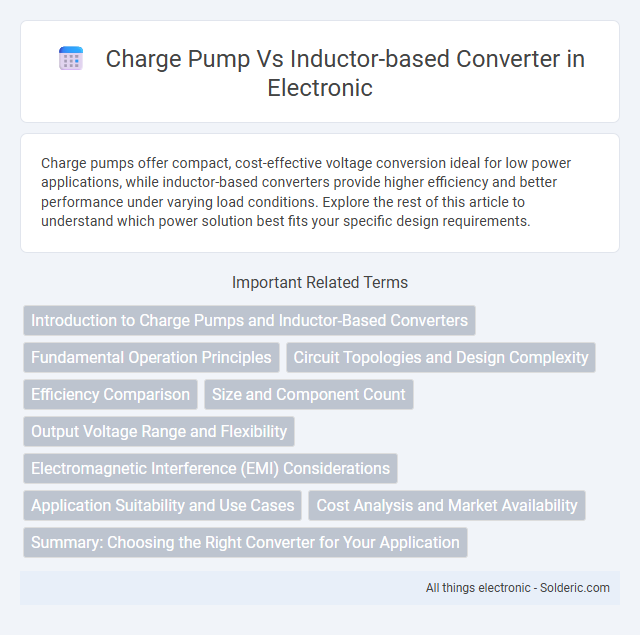Charge pumps offer compact, cost-effective voltage conversion ideal for low power applications, while inductor-based converters provide higher efficiency and better performance under varying load conditions. Explore the rest of this article to understand which power solution best fits your specific design requirements.
Comparison Table
| Feature | Charge Pump | Inductor-Based Converter |
|---|---|---|
| Energy Storage | Capacitors | Inductors |
| Size | Small and compact | Relatively larger |
| Efficiency | High at low current | Higher at medium to high current |
| Output Voltage Range | Fixed integer multiples of input voltage | Wide and adjustable output voltages |
| Switching Frequency | High frequency | Typically lower frequency |
| EMI (Electromagnetic Interference) | Lower EMI | Higher EMI due to inductor switching |
| Complexity | Simple design, fewer components | More complex, requires inductor and diode |
| Cost | Lower cost | Higher cost |
| Applications | Low power and space-constrained devices | Medium to high power applications |
Introduction to Charge Pumps and Inductor-Based Converters
Charge pumps utilize capacitors to transfer energy through switching cycles, enabling voltage conversion with minimal magnetic components, making them ideal for low-power, compact applications. Inductor-based converters use inductors to store and release energy, providing higher efficiency and power density for a wide range of voltage conversion tasks in portable devices and power management systems. Differences in component complexity, efficiency, and output current capabilities determine their suitability across applications from battery-powered gadgets to industrial electronics.
Fundamental Operation Principles
Charge pumps transfer energy by switching capacitors between different voltage levels, effectively stacking charge to increase or decrease voltage without inductors. Inductor-based converters rely on magnetic energy storage in inductors, using switching elements to control current flow and convert voltage levels efficiently. Charge pumps are ideal for low power, low noise applications, while inductors manage higher power with continuous current flow.
Circuit Topologies and Design Complexity
Charge pump converters utilize switched capacitor networks for voltage conversion, resulting in simpler circuit topologies with fewer passive components and no inductors. Inductor-based converters employ magnetic components like inductors and switches, leading to more complex topologies that require careful design for inductor selection, core loss management, and electromagnetic interference control. This complexity impacts PCB layout, component size, and overall system integration, making charge pumps ideal for low-power, compact applications while inductor-based converters suit higher power, efficiency-critical designs.
Efficiency Comparison
Charge pumps typically deliver high efficiency at low power levels due to their simple architecture and minimal electromagnetic interference, but their efficiency drops significantly under higher load currents. Inductor-based converters generally provide superior efficiency across a broader range of power levels, benefiting from energy storage in magnetic components and better regulation under varying loads. Your choice between these converters should consider the specific load requirements and efficiency targets, as inductor-based solutions excel in high-current scenarios while charge pumps suit low-power applications.
Size and Component Count
Charge pumps offer significantly smaller size and reduced component count compared to inductor-based converters, relying primarily on capacitors rather than bulky inductors. This compact design makes charge pumps ideal for space-constrained applications where minimizing board area is critical. Inductor-based converters, while typically more efficient for higher power levels, require larger magnetic components, increasing overall system size and complexity.
Output Voltage Range and Flexibility
Charge pumps typically provide fixed or limited output voltage ranges, making them ideal for low-power applications with modest voltage requirements. Inductor-based converters offer greater flexibility and a wider output voltage range, accommodating higher current loads and varying input conditions. Your choice depends on the need for precise voltage regulation and the complexity of the application.
Electromagnetic Interference (EMI) Considerations
Charge pumps generate significantly lower electromagnetic interference (EMI) compared to inductor-based converters due to their absence of magnetic components and switching currents that cause high-frequency noise. Inductor-based converters produce EMI from rapid current changes in inductors and high di/dt and dv/dt switching events, often requiring complex filtering and shielding solutions. Charge pumps offer a simpler EMI profile, making them ideal for noise-sensitive applications in compact and portable electronic devices.
Application Suitability and Use Cases
Charge pumps excel in low-power, space-constrained applications such as portable electronics and small sensor devices due to their simple design and absence of inductors. Inductor-based converters are preferable for high-current or high-efficiency requirements, commonly used in power management for CPUs, automotive systems, and industrial equipment. Your choice depends on power output needs and size constraints, with charge pumps favoring compactness and inductor-based converters ensuring robust performance in demanding environments.
Cost Analysis and Market Availability
Charge pumps generally offer lower production costs due to their simpler design and fewer external components compared to inductor-based converters, making them highly cost-effective for low-power applications. Inductor-based converters, while more expensive due to costly inductors and complex circuitry, provide higher efficiency and better performance in high-power scenarios, which sustains their demand in industrial and automotive markets. Market availability reflects this distinction, with charge pumps widely used in consumer electronics and portable devices, whereas inductor-based converters dominate sectors requiring robust power management solutions.
Summary: Choosing the Right Converter for Your Application
Charge pump converters are ideal for low-power, space-constrained applications due to their compact size and efficiency at lower current levels, while inductor-based converters excel in handling higher power demands with better regulation and efficiency across a wide load range. Your choice depends on factors such as output current requirements, voltage conversion ratio, and allowable electromagnetic interference. Selecting the appropriate converter ensures optimal performance and energy efficiency tailored to your specific application needs.
charge pump vs inductor-based converter Infographic

 solderic.com
solderic.com